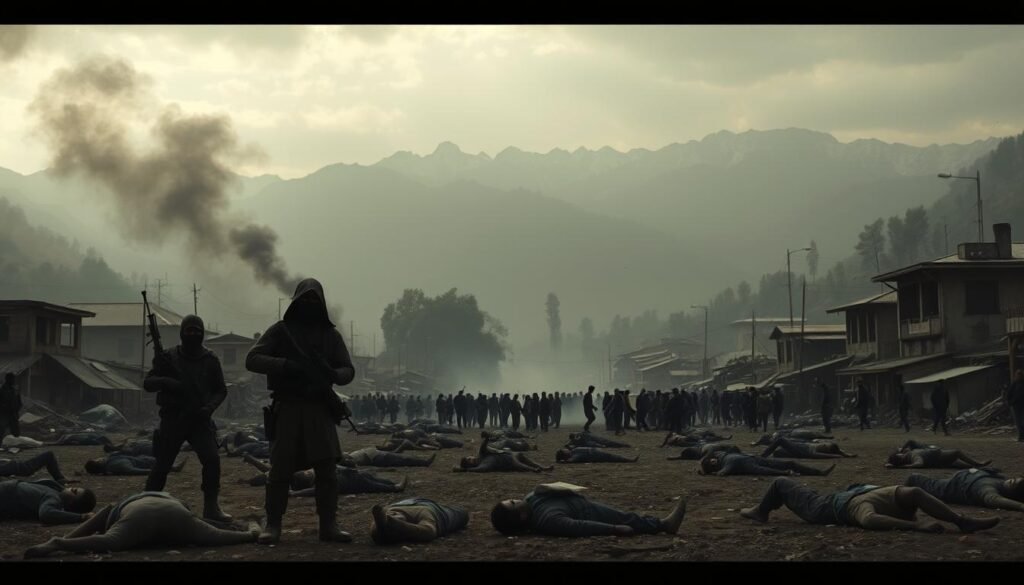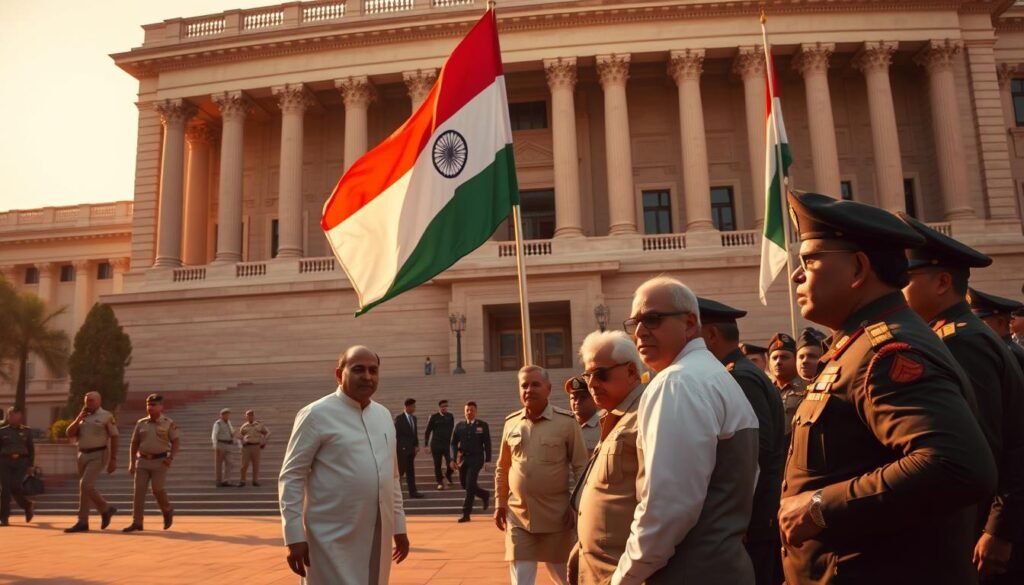After the Pahalgam terror attack, India showed its strength and unity. The attack shook the nation’s sense of safety. But, just like after natural disasters, India came together.
When faced with challenges, India’s security forces stepped up. They launched Operation Mahadev, a well-planned response. This operation shows the bravery and strategy of our forces as they protect our homeland.
Key Takeaways
- The Pahalgam terror attack prompted a swift and resolute response from Indian security forces.
- Operation Mahadev illustrates the strategic planning involved in counter-terrorism efforts.
- The collective resolve of India strengthens in times of crisis.
- Ongoing assessments are critical for improving national security infrastructure.
- The lessons from Operation Mahadev are shaping the future of India’s anti-terror strategy.
Overview of the Pahalgam Terror Attack

The Pahalgam terror attack happened on [exact date if known]. It targeted a community in Kashmir’s beautiful landscape. This attack hurt innocent people and security forces, causing widespread shock.
Many lives were lost, and people felt less safe. The government quickly reacted. They condemned the attack and vowed to protect everyone better.
The public was outraged. They wanted the military to take stronger action. The need for Operation Mahadev became a major topic in discussions about safety and fighting terrorism.
National Response to the Attack

After the Pahalgam terror attack, the Indian government quickly acted. High-level meetings focused on creating fast counter-terrorism plans. This showed a strong national commitment to boost security, mainly in Jammu and Kashmir.
The government didn’t just react fast. They also worked on better surveillance and teamwork between agencies. They saw the value in using new tech and sharing info. This helped security forces to get ready for any future dangers.
| Response Area | Description | Measures Taken |
|---|---|---|
| Surveillance | Increased monitoring in sensitive regions. | Deployment of advanced surveillance technology. |
| Coordination | Inter-agency collaboration enhancements. | Regular joint training programs and information sharing protocols. |
| Public Safety | Heightened security presence in public spaces. | Increased patrols and checkpoints in urban areas. |
This wide-ranging strategy shows India’s strong stance against terrorism. It shows the government’s focus on keeping the country safe. Their ongoing efforts to strengthen anti-terrorism measures help fight threats now and in the future.
Understanding the Mood of the Nation
The mood of the nation after the Pahalgam terror attack was filled with anger and strength. People across the country showed their support for the armed forces. Social media was filled with messages of sadness and outrage, leading to calls for better national security.
Many protests took place in big cities, where people came together to express their feelings. They demanded a strong fight against terrorism. This showed a united national spirit, refusing to let fear win.
The media played a big role in sharing these emotions. They reported on the strong calls for action and the personal stories of those affected. This showed a country ready to face its challenges together.
Intelligence Gathering Phase
The intelligence gathering phase was key before Operation Mahadev. Our forces tracked suspected terrorists for two weeks. They used advanced technology and human resources to do this.
This careful work gave us important information about terrorism support networks in the area.
14-Day Tracking Operations
For 14 days, we used top-notch surveillance methods. Our teams watched different places, studying the behavior and hiding spots of our targets. This work was vital for the operation’s success.
Encrypted Communication Intercepts
Decoding encrypted messages was a big part of our intelligence work. These messages showed us what the suspects were planning and who they were working with. By understanding these messages, we could target them more accurately during Operation Mahadev.
Deployment of Forces
As we moved from gathering intel to taking action, deploying special forces was key. We worked closely with the army, paramilitary groups, and local police. This teamwork helped us use each group’s strengths better.
One big challenge was the tough mountain terrain. We had to plan carefully to move troops safely and keep our mission secret. We also aimed to avoid harming civilians.
The strategy for deploying troops included several important steps:
| Element | Description |
|---|---|
| Coordination | Collaboration between army, paramilitary, and police forces |
| Logistics | Transporting personnel and equipment through rough terrain |
| Secrecy | Ensuring minimal visibility during troop movements |
| Community Safety | Implementing measures to avoid collateral damage |
This phase taught us a lot about success in security operations. Good troop deployment and care for local safety are vital. They help us fight terrorism better.
Execution of Anti-Terror Operations
Carrying out anti-terror operations in tough places needs careful planning and action. The Dachigam forests’ rough terrain was a big challenge. Our teams had to climb steep hills and move through thick plants while keeping their work smooth.
Knowing the local area was key. Guides helped us find safe ways and spots where enemies might hide.
Terrain Challenges and Strategy
Our plan for fighting terror changed as we faced the tough terrain. New tools like drones with cameras helped a lot. They let us watch and act fast when we saw danger.
The Indian military showed great flexibility during this fight. They worked well together, using their resources wisely. They kept checking the area and the enemy’s plans to stay ahead.
Operation Mahadev: Detailed Breakdown
Operation Mahadev was a big effort to take down terror groups linked to the Pahalgam attack. From the start, the mission was planned carefully, considering many important factors. It showed a detailed strategy, using intelligence, force, and target selection.
The planning phase was based on lessons from past missions. This made sure the team was ready for any challenges. Knowing the area and local conditions was key to making strategies that could change as needed.
Key goals of Operation Mahadev were:
- Disrupting terror groups in the area
- Finding and stopping key terrorists
- Making the area safer for local people
The operation’s plan focused on both short-term and long-term goals. It showed that careful planning and action can fight terrorism well.
| Phase | Description |
|---|---|
| Planning | Detailed analysis of previous operations to refine strategies. |
| Intelligence Gathering | Using technology and field reports to find targets. |
| Deployment | Putting forces in the best spots for success. |
| Execution | Working together to remove threats with little harm to civilians. |
Strategic Location: Mahadev Peak
Mahadev Peak is a key spot in the fight against terrorism. Its location offers a strategic military positioning that helps and hinders operations. From its high spot, our forces can watch enemy movements, helping with planning and gathering intel.
The peak’s height lets us see over paths used by terrorists. This makes it easier to keep an eye on them. Knowing the area around Mahadev Peak helps military planners. They use the land to their advantage and avoid its dangers.
For years, Mahadev Peak has been important in military battles. Its role today shows how important geography is for winning. It shows we need to be flexible and think about the land when planning.
In short, Mahadev Peak is a key area for our military. Its strategic military positioning shows how vital it is to know the local area. This knowledge helps us make better plans to fight terrorism.
Dachigam Forests: The Encounter Zone
The Dachigam forests were key in Operation Mahadev. They were a vital encounter zone for battles with insurgents. This area, with its varied landscape and rich wildlife, offered both benefits and challenges to our forces.
The forest’s unique terrain helped our military use stealth and precision. The dense paths and foliage made it hard to move but also helped us outsmart the enemy. Our troops used the terrain to their advantage, gaining a tactical edge.
Our strategy also considered the environment, like temperature changes and seasonal plants. Knowing the local ecosystem helped us predict where the terrorists would move. Each battle in this area gave us valuable information on enemy tactics and how to counter them.
Details of the Encounter
In a major terrorist encounter, our forces took down three terrorists. This is a big win in our fight against terrorism. Our security team showed great skill and bravery, facing tough resistance.
The battle was intense, but our team’s smart moves paid off. This shows how well-trained and determined our security team is.
Three Terrorists Eliminated
The death of these three terrorists is a big hit to terror groups. Each one was a serious threat, based on what we knew before the fight. Their death is a big step forward for our national security.
This success is part of a bigger plan to stop these groups. It helps keep us safer and more secure.
Identity Revelations of the Terrorists
We now know who these terrorists were and why they were fighting. Learning about their affiliations and goals is very important. It helps us understand the bigger picture.
This knowledge is key for keeping us safe now and in the future. It helps us prepare for any threats that might come our way.
| Terrorist Name | Affiliation | Status |
|---|---|---|
| Ali Khan | Terrorist Group A | Eliminated |
| Ravi Singh | Terrorist Group B | Eliminated |
| Farid Ahmed | Terrorist Group A | Eliminated |
Impact of Suleiman Shah Killed
The death of Suleiman Shah is a big deal in the fight against terrorism. He was involved in many terrorist groups, causing a lot of harm. His passing will likely change how these groups work.
The Role of Suleiman Shah in Terrorism
Suleiman Shah played a key role in planning attacks. He used his connections to recruit and train terrorists. His work aimed to destabilize the area.
His death could mean big changes for terrorism. It makes us wonder who will take his place and how they will lead. This could affect how well these groups can operate.
Ongoing Security Assessments
After Operation Mahadev, we know how vital ongoing security checks are. These checks are key to keeping us safe and stopping threats before they start. By looking closely at how the mission went, we can get better at what we do.
These assessments help us spot weak spots and watch areas that might be risky. What we learn from each step helps us face new threats better. This way, we keep our defenses strong and make sure everyone stays safe.
Using data from our operations helps us act fast. These checks let us stay ahead, changing our plans as needed. Our goal is to learn from each step, making sure we’re always ready for what comes next.
Strategic Aftermath of the Operation
After Operation Mahadev, clear steps were taken to make the area safer. Authorities carried out detailed searches to get rid of any remaining dangers. This was done to protect the people and keep the area secure.
Combing Operations in Surrounding Areas
Searching for any hidden enemies was a top priority. Teams with special skills were used to cover all areas, even the tough ones. Working with the community was also key, as it helped gather important information.
These actions helped bring back peace and trust in the community. Police worked hard to keep the area calm and safe. Their efforts show their dedication to keeping everyone safe from future threats.
Broader Implications for Terror Networks
Operation Mahadev marks a big change in how India fights terrorism. The Indian government has shown it will not back down against threats. This move not only takes out immediate threats but also changes how these groups operate.
Looking at the effects on terror groups, we see a few things happening. The better training and tech used by security forces will make these groups rethink their plans. They will have to change how they get new members and how they work.
This could also make it harder for these groups to talk and work together. They might start to break apart. It’s important for security experts to keep updating their plans to stay ahead of these changes.
| Aspect | Current State | Anticipated Changes |
|---|---|---|
| Recruitment Strategies | Focus on local discontent | Shift to covert operations |
| Operational Tactics | Utilization of basic arms | Increased technological use |
| Network Interconnectivity | Strong regional ties | Potential splits and isolation |
| Counter-Intelligence Measures | Reactive approach | Proactive intelligence-driven tactics |
Lessons Learned from Operation Mahadev
Looking into Operation Mahadev shows us key insights for fighting terrorism. These lessons learned help make future tactics stronger. They are important for the ongoing battle against terrorism.
One big lesson is how important it is for different security forces to work together. Good communication and teamwork between agencies make operations better. This shows the need for constant training and joint exercises to work as one.
Sharing intelligence is also critical. Quick and accurate info exchange between agencies can stop threats before they grow. Operation Mahadev proved that strong intelligence networks are key to stopping threats early.
Dealing with different terrains brings its own set of challenges. Urban and rural areas need different strategies. This is a key lesson from Mahadev’s operations.
Future of Anti-Terror Strategy in India
As we face modern threats, India’s anti-terror strategy will evolve. It will rely on lessons from recent operations. We need a new, proactive approach, focusing on community engagement.
Community policing is key. It lets local voices help, building a strong bond between police and people.
Technology will be essential in our strategy. Advanced surveillance tools will help track threats quickly. Artificial intelligence and data analytics will change how we predict and tackle risks.
Working with the private sector is also important. Together, we can tackle radicalization’s causes. This partnership will make our society stronger against threats.
What This Means for Indian Security Forces
Operation Mahadev marks a key moment for India’s security forces. It shows their strategic strength and the need to keep adapting to new threats. As threats get more complex, our training and resources must also evolve.
Enhanced skills and tactics are key to tackling future threats. This operation’s success goes beyond immediate gains. It makes us think about how agencies work together better.
Good communication and teamwork between different units are now more important than ever. This could change how we fight terror in the future. We must stay ready to face any danger that comes our way.
The bravery and dedication of our security forces are truly inspiring. Their efforts during Operation Mahadev push us to keep improving. We must stay strong and protect our country for a safer future.




